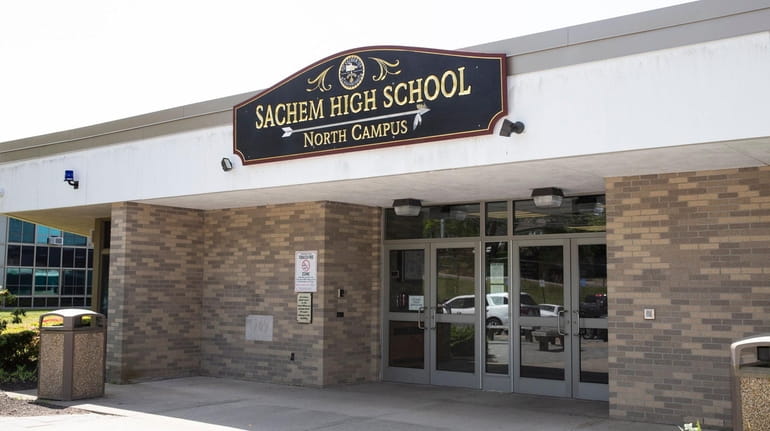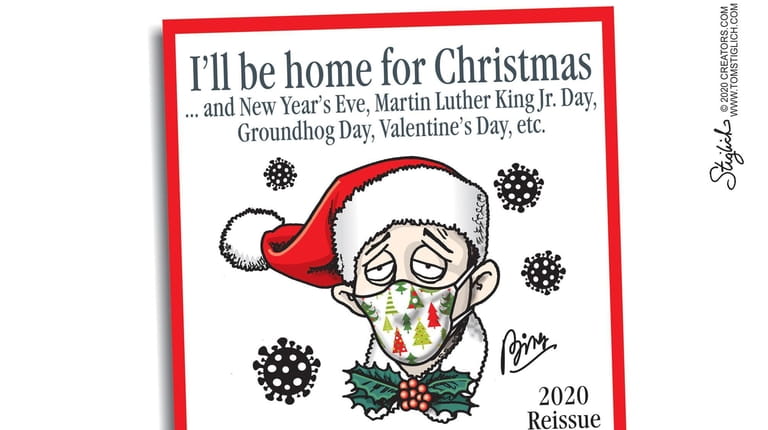Uncertainty abounds

Sachem High School North in Lake Ronkonkoma as seen on May 22, 2019. Credit: Anthony Causi
Daily Point
Long Island schools open to closures
When New York City Mayor Bill de Blasio announced Wednesday afternoon that city schools would go fully remote starting Thursday, the move kickstarted conversations about closures on Long Island that were already bubbling up.
De Blasio’s decision came as the city’s seven-day average of test positivity exceeded 3%, after a week of flirting with it. But as early as last Friday, Long Island parents and educators were bandying about the idea of sending kids home from Thanksgiving through sometime in January, as many of the nation’s colleges are doing.
On Friday, Sachem School District Superintendent Christopher Pellettieri put out a letter to the district announcing "four new COVID–19 positive cases this past week: one at East HS, two at Hiawatha and one at Waverly Elementary School."
He also addressed a rumor, that Sachem schools would go all-remote after next week’s holiday. "Obviously, the time has come to have this discussion and for our schools to be prepared for a transition to distance learning if forced to move in that direction either by Executive Order from the Governor or by the events around us."
Pellettieri put the issue on Wednesday night’s board of education meeting.
But it’s not yet clear how many other districts will follow the city’s decision. Nassau BOCES Superintendent Robert Dillon said he won’t be surprised to see a lot more districts considering it.
"It’s like calling a snow day," Dillon said. "Once one district does it, they start to fall like dominoes."
Dillon, who appeared at a news conference with Nassau County Executive Laura Curran to argue that in-person learning can continue this year if people will mask, distance and follow health guidelines, said that 106 schools in Nassau County have closed for at least one day due to COVID-19 since reopening in September, and about 20 have had to close for two weeks. And he said there is more than one model for closures, including the targeted one BOCES itself has adopted.
"We’re going remote for one full week after Thanksgiving," Dillon said. "We know people are going to travel and see family, we know we can’t stop that. But this gives us a week after to see who gets infected or has contacts that demand testing, and figure it out before we bring all our students and staff and teachers back to the BOCES."
—Lane Filler @lanefiller
Talking Point
A (mostly) grim outlook for the MTA
The battle lines were drawn quickly Wednesday, after the Metropolitan Transportation Authority presented a bleak budget scenario that reflected what might happen if no federal stimulus comes.
It was a picture of a $16 billion deficit, with more than 9,000 layoffs, including 933 at the Long Island Rail Road and Metro-North Railroad, and service cuts of up to 50%.
Among the board members lamenting the grim statistics, New York City and Long Island labor leaders, who took a particularly tough stance.
Take Vincent Tessitore, who represents the largest LIRR union — the Sheet Metal Air Rail Transportation Union.
"Not one essential worker should be at risk of losing their jobs," Tessitore said.
Later, John Samuelson, the president of the Transit Workers Union, noted that far more job cuts were coming from New York City Transit, as compared with the LIRR and Metro-North, adding that there were equity concerns in those disparities.
But Samuelson said that in the end, the unions will all be on the same page: Against the proposal.
"When this comes, there will be a fight back from the unions, and it will be a collective fight back, both on the railroads and within the city," Samuelson said.
Samuelson’s alternatives ranged from more borrowing until ridership rebounds to leaving the budget unbalanced, despite legislation that requires the MTA’s budget to be balanced, to believing that federal stimulus will come in 2021. And he noted a need for new revenue sources, beyond the cuts being proposed.
But he, too, took a hard line when it came to the impact on workers.
"We’re not going to open up our contracts. We’re not giving up concessions to bankroll this deficit," Samuelson added.
But beyond that, the constant refrain from board members and MTA officials was the need for federal funding.
"This is a national crisis requiring a national solution," MTA chief executive Pat Foye said.
Also discussed Wednesday, just in case the story for commuters couldn’t get worse: Fare hikes.
Everything from fare increases across the board, potentially about 4%, to vast changes to how the LIRR fares work, will be discussed in the coming weeks. Public hearings on those proposals are coming next month.
But board member Kevin Law, who heads the Long Island Association, noted during the meeting that fare increases, especially on regular commuters, might not be wise at a time when the MTA hopes to increase ridership.
"We need to be luring riders back," Law said.
Buried in the heap of bad news was a sliver of good news that normally might have been a headline: The Long Island Rail Road is on schedule — yes, on schedule — with its effort to institute positive train control safety technology by the federal deadline at the end of this year.
if you call an incomplete project that was originally required by federal law to be completed by Dec. 15, 2015 ‘on time'.
—Randi F. Marshall @RandiMarshall
Pencil Point
Home for the holidays 2020 edition

Tom Stiglich
For more cartoons, visit www.newsday.com/cartoons
Final Point
A matter of public confidence
As a contentious news conference with Gov. Andrew M. Cuomo was taking place in Albany on Wednesday over rising COVID-19 infection rates in the state and the closure of NYC public schools, the governor was getting some virus flack from an unexpected source downstate.
The American Medical Association told Newsday’s editorial board that the demands by Cuomo and other governors for an independent safety review of coronavirus vaccines could delay or undermine public confidence in the drugs. "The expedited process to develop a safe and effective COVID-19 vaccine must not be compromised in any way by political influence or any consideration that lies outside of evidence-based science," Dr. Susan Bailey, a Fort Worth immunologist and the current president of the AMA, told the board during a virtual meeting on Wednesday.
Bailey said it was her third meeting with an editorial board in the group’s campaign to tamp down criticism by state elected officials of the federal review process. She said that Cuomo’s Clinical Advisory Task Force is not necessary because the scientists and career public health officials in the federal government are best suited to review the voluminous research data being turned out by drug manufacturers. "We are concerned that adding new task forces to review the vaccine data will add complexity to the review process and might come to different conclusions than the FDA," she said. She also said that like Cuomo, plans by California Gov. Gavin Newsome and other western governors for a safety review committee could undermine trust in the FDA approval process.
While Bailey denounced all political interference with the approval process, she didn’t directly address the issue of whether the White House’s mishandling of the coronavirus pandemic had undermined public confidence.
Public officials have a role in encouraging vaccine use, Bailey said, adding that it should not extend to reviewing the scientific data. "This is a public health issue and their affirmation is incredibly important, she said. "We don’t think there is a need for them to get into the weeds."
— Rita Ciolli @ritaciolli
